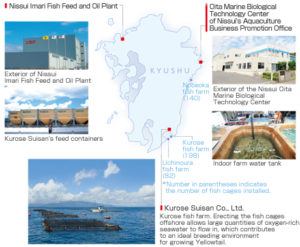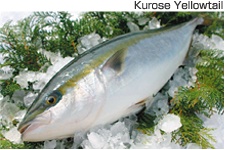Don’t take that sushi for granted: Nissui’s battle with the changing ocean

As climate change directly impacts fisheries in Japan, companies test “Koritsuka” fish farming, and global expansion.
Next time you reach for that box of sushi, imagine the Salmon and Tuna switched with all Yellowtail. Climate change heavily effects fisheries as rising sea levels alter habitats and changes fish distribution all around the world. Nihon Suisan (literal translation: Japan Fisheries Co), as a company based in a country with the second largest seafood consumption globally, takes action to combat global warming through vertical integration, fish farming, and diversifying its fishing risks.
There are many aspects of climate change that directly impacts fisheries, especially because companies are not completely mobile when catching or distributing fish as it is confined within the fishing proximity of each country. As ocean water acidifies, caused by the rising carbon dioxide levels, calcium carbon shell become difficult to form for organisms such as oysters and lobsters. [1] As ocean temperature rise, certain species also shift out of its traditional habitats, seeking for its ideal water temperature essential for survival. Furthermore, as sea surface temperature rises, reproduction cycle would be effected due to fish only being able to reproduce in a narrow temperature range. In addition, water temperature influences the sex of fish, which could eventually cause a major shift in the dynamic of the fish population. [2]
Nihon Suisan (“Nissui”) gains over 40% of its sales from fisheries, while also expanding on its food manufacturing, fine chemical, and trading businesses. There are many ways in which Nissui address climate change, both in the directly and indirectly, to sustain resources and its business in the long term. In order to lower the company’s CO2 emissions, Nissui has installed an Environmental Committee that overlooks all parts of the business. In 2012, Nissui established a logistics company to store, ship, and trade its fish and processed food products. By minimizing transportation, packaging, and shipment costs, the company has been successful in reducing 168,000 tonnes of CO2 in a year. [3] Furthermore, Nissui has in place the 3R’s (Reduce, Reuse, Recycle) and placed a goal to achieve zero emission in all its domestic factories. Three factories have already achieved zero emission in 2012, as employees visually check (“mieru-ka”) whether waste could be eliminated by adjusting packaging size or changing machine parts so no residuals of the processed food has to be thrown away. By allowing employees to voice opinions as they identify wastes, Nissui has led the fishery and food processing industry to eliminate CO2 emissions. [4]
Nissui began fish farming in 1994 and now ships over 1.2 million Yellowtails at its main farm in the Miyazaki prefecture. The farming of Yellowtail begins with artificial seedling technology, and is raised in calm and pristine waters until it is about 1kg. The fish are then transported into large fish cages submerged underwater to protect them from changing ocean temperatures and natural disasters. By adjusting sea temperature manually through the usage of fish cages and raising Yellowtails in a controlled environment, the company addresses the problem of shifting habitats for fish and maintaining the dynamics of the fish population. Nissui has also begun researching possibilities to implement fish farming to other fish such as Salmon and Tuna, in hopes to maintain the natural habitat of fish and turning to artificial seedling to answer to the rising demand for seafood across the globe. [5]


In order to further answer to rising demand and address the risk of climate change in fisheries, Nissui has acquired companies abroad to diversify oceans they fish in. By maintaining a presence in all the oceans of the world through its “True Global Link” program, Nissui’s short term solution to the changing ocean climate will help make way for a steady supply of fish to its largest customer base, the Japanese households. [6] Although there is currently no regulation put in place for fishing that is directly related to the changing climate, this preemptive measure will also help diversify the source of fish when change in regulation does occur.
Nissui has already taken many measures to address the long term and short term effects of climate change, both in a small factory level to a large portion of their fisheries business. The company has started to implement vertical integration in its supply chain by controlling all aspects of fishing farming, processing, packaging and shipping. I would suggest Nissui to expand on its fish farming business despite the risk it carries, and to implement vertical integration to its overseas subsidiaries as well. Because the company has a large influence on large fisheries globally, if installed successfully, fisheries could be sustainable in changing sea climates, as well as reduce CO2 emission significantly. This way, we can hopefully keep eating that box of sushi.
(775 words)
[1] “Ocean Acidification.” Smithsonian National Museum of Natural History. Web.
http://ocean.si.edu/ocean-acidification
[2] “Climate Change Impacts On Fish.” Great Barrier Reef Marine Park Authority. Web
[3] “Environmental Report 2014.” Nihon Suisan, Company Report. Web. (Translated)
http://www.nissui.co.jp/social/environment/pdf/2014_env.pdf
[4] “Environmental Report 2014.” Nihon Suisan, Company Report. Web. (Translated)
http://www.nissui.co.jp/social/environment/pdf/2014_env.pdf
[5] “Yellowtail Aquaculture Business Using Artificial Seedlings.” Nihon Suisan, Corporate Information. Web.
http://www.nissui.co.jp/english/corporate/frontier/23/
[6] “Global Supply Chain.” Nihon Suisan, Corporate Information. Web.
http://www.nissui.co.jp/english/business/supply/index.html



Wow! What a fascinating post, Irene, not least because I had no idea that water temperature influences the sex of fish.
I think that Nissui is smart to be getting into the farmed fish business, though it will be interesting to see if consumers are willing to accept farmed fish over wild fish. If not, Nissui might still find itself in, well, deep water.
Further, as we have seen with farmed animal operations in other food categories, Nissui will have to resist the temptation to maximize efficiency in producing fish at the cost of perverting nature. This has already been seen in fish farming to some extent, through the use of antibiotics and untraditional diets: http://well.blogs.nytimes.com/2014/12/18/ask-well-wild-fish-vs-farmed-fish/?_r=0
My guess is that the average Japanese consumer would not tolerate similar contamination, though absent regulations many companies would make this mistake.
Further, Nissui’s worldwide fishing operations are surely a necessary step as fish migration patterns continually adapt to warming oceans. The company would benefit from investment in fish-tracking and fish-tagging technology, as finding the schools is crucial to their entire supply chain.
Sadly, though, the acidification and warming of our oceans is inevitable (http://www.nytimes.com/interactive/2016/09/12/science/earth/ocean-warming-climate-change.html), and no company could possibly change the issue singlehandedly. I admire Nissui’s commitment to sustainability in their operations, but a wider, worldwide movement will be necessary to save our fish, along with most other species on earth.
Interesting post! As Kiernan says, people sometimes try to avoid farm raised fish and go for wild fish. But it was shocking that Atlantic bluefin tuna was included in IUCN red list categorized as “endangered” (http://www.iucnredlist.org/details/21860/0). Regarding the sustainability, the notion of aquaculture is important. Nissui, or Kindai University are leading the related technologies, so developing the practices to the level of that we do not have to care about the health risks is really important.
I loved learning more about how climate change affects fish population and its diversity. You brought up a few excellent points that really highlight the complexity and interconnectedness of the whole ecosystem of fisheries. For example, the fact that water acidity increases is directly related to reducing in populations of oysters and lobsters. This will likely set a chain reaction and reduce populations of other species that rely on oysters and lobsters for survival (not humans, even though sometime we feel like we can’t live without oysters and champagne). Businesses that rely on fish production as a core activity are facing a tough challenge in rapidly changing climate world because of that interconnectedness. One degree of temperature change can/will set off a chain reaction and domino effect across multiple species and regions of fish.
Really interesting to see how one of the world’s largest fisheries cooperation is tackling the impact of climate change to its operations. Nissui’s strategy of vertical integration, research and diversification is a solid one, but admittedly this is a steep challenge to solve.
Having read the post and the comments, I wonder if Nissui is undertaking any consumer awareness initiatives to better educate the average Japanese consumer as to the impact of climate change and the effects of overconsumption, perhaps that might make them more receptive to farmed fish? Nissui can also potentially invest more in marine research and undertake fish stock rebuilding programs for their main catches, which is basically an effort to redevelop fish populations deemed at risk, back to their original population level so that fishing can continue sustainably. Something more extreme perhaps, but another interesting area of research that some developing countries are looking into is the creation biofuel with fish waste.
I also wonder if there is a role for more policy and governance in this matter. Fishing fleet overcapacity is one of the main drivers for wasteful overfishing across the world. There a few countries that have adopted a limit system called Individual Fishing Quota which caps the specific amount of fish that people were allowed to catch. This has been implemented in a few countries including New Zealand, Norway, Canada, and the United States, where it has successfully helped in fishing industries by reducing overfishing and mitigating climate change impacts on a broader scale.
Very interesting read, I also was surprised to find out how acidity of water changed the sex of the fish and the dynamics of the population.
I’m not sure how I feel about the manual adjustments to the sea temperature by the company. For the sake of sustainability, humans should not be engaging in activities altering the living habitats unless they are sure of the effects, which is usually not the case.
The strategy around vertical integration that will enable more control over the supply of fish also seems to be the most efficient way of tackling with the supply risk. I think that in addition to the vertical integration initiative, the company should also advocate for changes in fishing regulation to have a more sustainable supply in the long run.